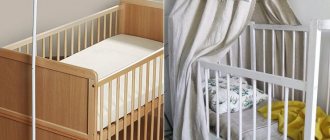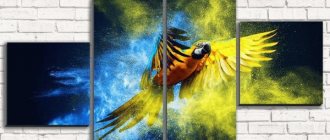How to hang a picture without drilling. Mechanical methods
As a rule, nails and screws leave behind quite large holes and even chips, which look unsightly and the holes from them must subsequently be repaired and painted over.
And that’s when simple but effective ways to attach pictures come to the rescue. There are several of them, and you will definitely find a suitable option for yourself.
No. 1. Paperclip or hook
This method is suitable for walls covered with wallpaper. On the wall, in the place where you want to hang the picture, make a horizontal cut. Fill the incision with superglue and insert a paperclip there, having first bent it into a hook. You can also use a coat hook as a fastening. Cover the place where we glued the paperclip or hook with wallpaper. This type of mount is suitable for paintings that are not very heavy.
No. 2. Button
Fastening using a button is done like this: make a cut in the wallpaper, pour glue into it, stick the button there and hide the base of the button under the wallpaper. All fasteners are ready! This type of mount can support a light painting.
No. 3. Spider hook
Such fastenings are sold in construction stores; they are called “spider hooks”. The mount has four sharp ends that are easily attached to the wall with a hammer. The hook will support a painting weighing about two kilograms and is securely attached to any wall.
No. 4. Needle
What kind of interior item is this fastener designed for?
This type of fastener can support a light painting or drawing.
To do this, take a sewing needle and stick it into the wall. You can also carefully drive a tailor's pin into the wallpaper.
The eye of the needle is also broken off and the sharp end is carefully driven into the wall. The hole from the needle is small and invisible, unlike screws and nails
Since the needle is made of steel, it has good strength and will reliably hold the picture.
No. 5. Double-sided tape
This fastener is suitable for walls covered with thin paper wallpaper and for plasterboard partitions. You just need to stick the tape on the edges of the frame and press it against the wall so that the picture sticks well to the wall surface. But this method has a disadvantage: the double-sided tape used after removing the painting leaves sticky marks. To avoid this, you need to hold the tape at an angle of 90 degrees with respect to the wall when you remove the picture.
No. 6. Velcro Command
This mount can be glued to any surface; it can support paintings up to two kilograms.
Command Velcro is very easy to remove from any surface. Velcro is sold in sets of several pieces. The principle of operation of Command Velcro is this: one Velcro is glued to the picture frame, the other to the wall surface. The weight of the painting depends on the number of strips, that is, the more Velcro, the greater the weight of the painting.
No. 7. Wine cork
An ordinary wine cork is cut into 1 cm thick washers and glued to the wall with glue that dries quickly. After the cork washer is glued, a small nail is driven into it, it will serve as a fastener for the painting.
No. 8. Ceiling plinth
This method is suitable for those who want to hang a lot of pictures without damaging the walls. Moldings () are sold in construction stores or markets. They are usually simply glued to the wall or ceiling, and then a strong fishing line is attached to it and only the pictures are hung on the fishing line.
Sewing needle
There is another fairly effective method, thanks to which you can attach a frame to a wall without nails.
There are several ways to use a mounting needle.
- The needle takes on the function of a regular nail. However, the damage to the wall is significantly less than using screws and nails. First of all, you need to use pliers to bite off the eye of the needle. Then you need to drive a needle into the wall. It is very important that the wall surface is made of soft materials: wood, plaster, drywall, and so on. Then you can hang the frame on the wall.
- The second method is much simpler and more effective. You need to stick the needle into the wallpaper at an angle of 10 degrees. This must be done so that the needle is between the wall and the wallpaper. After which you can hang a frame weighing up to 500 grams on it.
We recommend: Intex repair kit for air mattress and methods of application
How to hang a picture on a wall without drilling into the walls
How to hang pictures if you don't want to drill into the walls? We suggest using one of the following methods:
- A small picture can be attached to the wall using double-sided acrylic foam tape. One side of the tape is glued to the canvas, and the other to a previously prepared plane. There should not be a heavy load. There is also a drawback to this type of fastening: it is not durable and after attaching with tape, visible residue remains.
- Hooks for outfits and special mounts for pictures with adhesive backing are attached in the same way as in the previous method, only the canvas is hung on a hook.
- The picture is hung on a plasterboard wall using pins and paper clips placed under the wallpaper and secured with PVA and Moment glue. This method is also suitable for a concrete wall, but the picture should be small.
- “Liquid nails” is the name of a special glue that holds paintings well. Therefore, they are used for fastening the canvas and the hook. With their help, the canvas holds for a long time, because if it is torn off, it means ruining both the picture and the wall. This method is used to hang large paintings and also decorate the kitchen and bathroom.
- Quick-drying adhesives are also used in the following method. A small piece of wine cork, about 1 cm thick, must be glued to the cleaned wall. Then, as soon as the glue has dried, a screw or nail is attached to the cork, on which the picture is hung.
- There are also nails with hooks made of infusible metal. They are designed for various walls, they are driven in well, without leaving any marks. Such nails can hold heavy loads.
Regular hook
What is needed:
- hook;
- pliers;
- glue.
Peculiarities:
- maximum weight up to 1.5 kg;
- requires selection of a pattern for camouflage.
Execution algorithm:
- take a regular hook in your hands and, using pliers, bend it so that it can be applied to any flat surface;
- glue it to the wall with any glue;
- select a piece of wallpaper with a suitable pattern;
- glue in such a way that only the bent loop remains protruding;
- feel free to hang the picture.
This is what it looks like in the picture.
As you can see, the simplest way to quickly hang a picture on any wall surface. The only negative is the weight limit of the frames used. And if you don’t have a suitable one, then you can always make a frame with your own hands.
Options for attaching paintings to the wall without nails
It often happens that when one thing is there, the other is not, and then vice versa. So, when you want to assign the painting its own place where it will hang and not gather dust on a shelf, it turns out that either a nail or a hammer is missing.
A creative person knows more than one way to attach pictures to the wall without drilling.
Pay attention to the subtleties of completing each task in order to correctly and aesthetically bring your plans to life
There are a lot of options for mounting pictures. The main thing is to be smart and approach this matter creatively.
Tailor's pin
Creativity in the case of a tailor's pin is appropriate if the weight of the picture does not exceed half a kilo. This method is used to attach: paintings, small items and photographs.
Consider what kind of coating is located on the wall - paint or wallpaper. In the case of paint, you will need to take a small piece of paper, stick it to the wall and stick a pin in it.
In the case of both, everything happens exactly the same. The exception would be thin or loosely fitting paper. Attach the picture to the place where you will place it, outline it with a pencil or chalk. Cut it out. Select a thick piece of paper the size you cut out, glue it and secure with a pin. Ready.
This mounting option is only suitable for paintings of small dimensions and weighing no more than 500 grams.
Double sided tape
Easy and reusable fastening method. Permissible weight for paintings: up to 2 kilograms. Place the tape evenly in the place where you will place your creativity and attach a picture to them. The positive side of the method: lightness, the ability to use on plasterboard walls and light wallpaper. Negative side: when you want to change the place for the painting or take it away altogether, traces of the tape will remain in the place of the painting.
You can hang a picture weighing no more than two kg on double-sided tape.
Paper clip
The fastening will be the same as with a pin. Using pliers, bite off part of the paperclip so that its ends become sharp and stick it into the wall, wallpaper, or onto a piece of thick paper. The experiment showed that the paperclip can withstand the weight of a painting up to 1 kilogram.
This mounting option is similar to pin mounting.
Spider hook
Not a handy method, but a good alternative to nails. Buy a spider hook at a hardware store. Pros: easy to attach, leaves virtually no traces of attachment, for attaching paintings up to two kilograms. Such a spider is fastened with a hammer and a light blow; the hook is fixed in the wall with its four pointed ends.
Spider hooks are available in different sizes. And depending on the size, they can withstand weight up to 8-9 kg.
Velcro
They have a large selection of varieties. Basically it is a set of small sticky strips. Technique: one strip is glued to the picture frame, the second to the wall. Allowable weight: up to 2 kg. The more of these mounts, the more weight they can support.
The following rule applies here - the more Velcro, the more weight such a mount will support.
Cork
An option for small and medium-sized paintings on the wall without drilling is possible. After the holiday, save the wine cork or remove it from your collection if you use something similar. Cut and glue with superglue (preferably quick-drying) to the wall. The fasteners can be attached to this location.
Every home probably has a wine bottle stopper. This mounting method without drilling is possible for placing small paintings on the wall.
Cornice rail
A similar method can be seen in art galleries. At home, take an old cornice. You can also use a wooden strip, but you will need to attach hooks to it, like on a cornice. Pictures are hung from these hooks on fishing line or loops.
The curtain rail will allow you to place several paintings. They can be hung either at the same or at different levels.
Liquid Nails
The material allows you to attach non-massive paintings without nails. The appearance of liquid nails has nothing in common with metal nails. They are more like superglue. The actions are performed exactly the same. Cover the frame with glue and attach it to the wall
Pay attention to the evenness of the painting
Liquid nails are an adhesive substance that is a good alternative to regular nails.
Using the rail
How to attach a painting to a wall surface using this interesting system? It's actually not difficult. You can purchase a special rail of the required size at any hardware store. You also need to additionally buy a skein of nylon thread.
Attach the rail to the wall near the ceiling; ordinary liquid nails are suitable for this. Tie one end of the nylon thread to the rail and the other to the frame. Adjust the desired height.
Advice
By the way, this method is also suitable for attaching a decorative plate to the wall.
This design has its significant advantages:
- the ability to change the height of the work of art;
- you can hang several paintings in a row;
- no damage to walls or wallpaper.
How to hang a picture correctly (what you need for this + principles for placing pictures in the house)
How to hang a picture without damaging either the picture or the wall? What does that require? How can you learn to place decor so that the design benefits from it? All these questions have their own answer. They won’t be able to fit into one sentence, but it’s worth preparing first so that you don’t have to look for ways to correct what you’ve done.
Don't skip all the prep work. Before hanging a picture, you need to study the wall, measure the area and find the exact location of your picture, as well as decide on the type of mounting.Since designs are different and so are tastes, there is no universal advice on where it is better to place a painting. Start your piece by deciding where you want it to fit in the room. Please keep in mind:
- Size of the painting.
- The height of the ceiling of the room.
- Lighting.
- Lines of sight.
Please note that paintings that are large in size would be appropriate to place on a wall with a large area, and small ones on a small one. Consider this fact of relevance even at the stage of purchasing an accessory in a store.
Take into account the geometry of the room; it is better to place a horizontal picture on a long wall, and a vertical one on a high wall.
An interesting option for placing paintings - this uses the entire wall area. In this case, the main thing is to choose the right size and design of structures.
The format of the picture has good visual functions. By hanging a row of paintings in one vertical line, you can visually lengthen the wall. If you have chosen a place where you want the selected image to hang and the center of this image is at your eye level. So you are doing everything right.
Placing paintings on the same level will visually lengthen the room.
The order in the apartment had to be visible in everything: both in cleanliness and in aesthetics. Hang pictures at the same level.
Select paintings based on your feelings and tastes, do not be afraid to experiment.
Various Velcro
Light weight paintings can be hung using double-sided tape. The fastening is suitable for any surface, but there is an important condition - the walls must be even and smooth. It is better to choose fabric-based masking tape: it is more reliable. The principle of its use is approximately the same as adhesive fasteners.
Secure a strip of tape around the perimeter of the back of the painting and peel off the protective layer. Press the canvas firmly against the wall. This method is suitable for all walls, including plasterboard. However, after removing the tape, there is a danger that a piece of the wall covering will come off along with it.
Miss Clean magazine advises: to avoid damaging the walls during dismantling, use a little trick: peel off the tape at a 90-degree angle.
An alternative to tape is Velcro from a sewing store. They are designed to secure shoulder pads and pockets on clothing, but can also be used for other purposes. One side of the tape is glued to the photo frame using glue, and the other side is glued to the wall. The method is convenient because you can change the location of the picture as much as you like. The number of Velcro depends on the size of the canvas.
We recommend: How to properly starch knitted and regular napkins?
Marking methods
There are at least two ways to mark a wall for hanging modular paintings. The first is to trace the modules on the wall. Or rather, mark the corners of each fragment. We begin work with the central element of the composition. We apply the fragments to the wall one by one, tracing the corners. Don't forget about the distance between modules.
Modules often have different heights. To correctly position them relative to each other, select some moment that is present in at least two adjacent fragments. Make a mark on the wall (put a dot). On the modules that are in the middle of the composition, you need to put marks on the right and left. Align the next fragment according to the mark, move it to a specified distance, mark the upper corners.
Aligning a drawing by marks
When all the fragments are marked, we find the middle and install the selected fastener at the desired height. The “required height” is so that the top of the picture is at the mark made. It must be remembered that the stretched thread or installed bracket/loop is placed on a stretcher. In principle, a deviation of two, three, four or even five centimeters from the marks is not critical
It is important that the pattern on the fragments matches
Horizontal modules are rare
The second markup method is probably simpler. Take paper (newspapers, posters, leftover wallpaper, etc.), cut out copies of the elements of the modular picture. True to size. Place marks on the paper (as described above) so that you can correctly align the elements on the wall relative to each other. On paper, mark where the loops/staples are installed and where the fishing line is stretched.
We place paper blanks on the wall. You can secure it with pins (on the wallpaper) or buttons. In this option, you can evaluate whether you have chosen the right location and make adjustments. As you can see, the option is more practical. Next, in the place where the mark was made (there is a bracket or loop in the picture), we attach the hook. You can even do it through paper. Next, we tear off the paper and hang up the modular picture.
Method one: pin
Of course, you can hang a picture on the wall without drilling. If it is light and small, then improvised means are used as fasteners: push pins and paper clips, sewing pins and needles.
Paper clips are also useful, but they are no longer pinned, but glued to a wall covered with wallpaper. One edge of the paperclip is bent, making a hook out of it.
- In the place where you decide to hang the picture on the wall, two small cuts are made on the wallpaper with a sharp knife: one vertical to the length of the paperclip and the second horizontal in the middle of the first.
- The edges of the cut wallpaper need to be carefully lifted to free up a piece of the wall and create empty space.
- Glue is squeezed into the gap between the wall and the wallpaper, and a paper clip is placed on it so that the hook looks out.
- The flat part, pressed against the wall, is covered with wallpaper, returning their bent edges to their place.
- When the glue is completely dry (within 24 hours), the wallpaper will tightly fix the paper clip to the wall.
- For additional security, you can paste another piece of the same wallpaper over the cut, carefully aligning them according to the pattern.
Buttons and pins are good for attaching children's drawings, posters or photographs. The main advantage is that after removing the thin, sharp fasteners, the puncture marks on the walls are almost invisible. Holes in plaster or paint can simply be wiped with a rag.
But such fasteners cannot be used on concrete walls and cannot be considered reliable for paintings.
To achieve better fastening, it is advised to take a sewing needle, bite off the eye with pliers and drive the sharp end into the wall. The puncture will be very small, and the strong steel of the needle is quite capable of supporting the weight of a small, light frame.
Modern fastening systems
Today, more modern and functional accessories and tools for repairs and modern design are released almost daily. Progress has also affected fasteners for paintings and photographs.
Velcro for attaching pictures Command
This system can be used to hang a picture if it does not have a mount, without damaging the wall surface. Velcro Command
They are plastic fasteners that are attached to any type of covering.
Such Velcro consists of two parts and can be reused. In order to attach a picture using such fasteners, you should attach one part to the wall, the second to the picture.
Before installing such fasteners, you should prepare the surface and degrease it. Thanks to this, you will further increase adhesion to the wall.
Hook for fastening the Kreps system
This system is intended for paintings, photo frames and other decorative interior items that have special ropes or cables as part of the fittings. This is due to the fact that the design provides for the presence of special hooks on its surface, which do not leave traces after dismantling and make it possible to hang the picture even on a concrete wall.
One such hook can withstand a weight of 1-1.5 kilograms. But if you want to hang a large and heavy item, you can use several hooks at once. The most important thing is to correctly calculate the number and placement of these fasteners. The picture should fit tightly to the wall.
In order to install such a hook, you will not need much time, since this is a fairly easy operation, and even a child can cope with it:
- You need to remove one side from the protective layer and glue it to the wrong side of the hook.
- After this, remove the protection from the other side and attach it to the wall.
- Hold in this position for about 30 seconds, after which you can safely hang decorative elements.
Dismantling is even easier. You just need to pull out the tab, thanks to which the unsticking will occur.
As you can see, there are many methods for hanging a painting, photograph, poster or other decorative elements without drilling huge holes in the wall. We have offered you the most popular and proven methods. Therefore, you can easily complement the design of your room and change it at your discretion at least every day.
Since ancient times, people have sought to decorate their home with a variety of decorative things: panels, photographs, masks, decorative hanging figurines, amulets, paintings.
Pictures have always been hung on walls, and sometimes situations arise when it is not possible to drive a nail or screw into a wall or there is no one to do it.
We will talk further about paintings, or more precisely, about their mounting on walls. Shall we look at ten options? how to hang a picture correctly using different fastenings.
Best Mounting Methods for Lightweight Paintings
How to hang photos in a few minutes? Let's start with perhaps the most well-known method. Using regular pushpins and pins, you can hang pictures on the wall. The good thing about using a pin is that it leaves an almost invisible mark. If in the future you want to remove the piece of art from the wall or move the painting to another location, there will be virtually no damage left.
The same can be said about push pins. Just press the photo against the wall with them and it will hold tightly.
Advice
How to hang photos on a concrete wall? This cannot be done using the method described above. Buttons are effective only if the wall consists of drywall, plaster, wood and other not too hard materials. Buttons cannot overcome a monolithic concrete wall.
These methods have one significant drawback - this way you can only attach posters, posters and photographs.
We recommend: Several ways to carefully and quickly remove old paint from batteries
Backlight
Everyone has seen the decorative lighting of paintings in museums and galleries.
Directed streams of light focus attention on the image, forcing you to stop and examine it in detail. It is recommended to use natural lighting in residential areas, because sunlight helps any story to fully unfold
Decorative lighting is needed only in two cases:
- On the glass protective surface of the painting there are reflections that make it difficult to see the plot.
- This decorative element should become the center of the interior composition. Perhaps due to the neutrality of the plot or pastel colors, it is slightly lost in the setting.
It is better to use LED bulbs as lighting. They will last a long time and do not heat up during continuous operation. A group of light bulbs in a metal “frame” against the background of a brick loft wall will look stylish and unusual. One above each picture.
Features of placing paintings
To make the picture look advantageous, it is important to choose the optimal location. The canvas should organically complement the interior
Selecting a location
The painting should be located in a bright room. It is worth considering that frames with a still life or landscape attract maximum attention.
In this case, the canvas should not be in direct sunlight. Otherwise, the image will quickly fade. In addition, it is recommended to avoid glare. This is true for paintings covered with glass.
Availability of backlight
In dark rooms, paintings can also look very impressive. If there is not enough lighting, special lighting will help to emphasize the subject of the image. The light flux evenly covers the picture without creating glare or shadows. Therefore, the source must be at a certain distance from the canvas.
Height selection
When choosing the height of the painting, you should take into account the features of the interior
Ceiling height is important
It is recommended to look at the image at human height level. The bottom of the frame should be located in the eye area.
Before mounting, the product should be attached to the wall. This will help assess the location of the canvas from the side.
Incline
Paintings placed at eye level are hung parallel to the wall. However, sometimes the top edge is tilted a little. It depends on the height and preference of the person.
With proper selection of the angle, the distance from the person’s eyes to all points in the picture should be approximately the same. Thanks to this, it is possible to see small elements much better. This method helps prevent glare.
Reliable methods
Let's look at how to hang heavier decorations. Sometimes you need to place a picture in a massive frame, a clock in a metal case, decorative panels or other things on the wall. It will not be possible to use simple methods here, since excessive load is unacceptable for them. We have to choose more reliable methods that allow us to obtain the expected result without drilling the surface of the walls. There are several good options that should be discussed in more detail:
Picture board
This option can be classified as the most radical method. To hang pictures, a special plane is used, attached to spacers to the ceiling slab and to the floor. You can create a large shield with paintings placed on both sides. To do this, the board is installed across the room, dividing the room into parts.
Since fastening requires direct contact with the ceiling slab, rooms with suspended or suspended ceilings are not suitable for implementing this method. The plane itself can be made from any sheet material - MDF, chipboard, plywood or plasterboard. Natural boards joined into a board or laminated materials are suitable. If desired, you can use the same material from which the furniture is made. This will help create a cohesive, stylish interior of the room.
Polymer glue
Polymer adhesive compositions do not leave greasy marks on the wall. They are practical and relatively inexpensive. Users recommend polyurethane adhesive, which is strong and reliable. If you need to install a large picture, glue the entire frame around the perimeter. For products of medium size and weight, it is not necessary to apply glue to the entire supporting surface. The picture is applied to the wall and propped up with some oblong object (a stick, a mop handle) and left overnight.
Liquid Nails
This composition allows you to fix the picture on the wall for a long time. The glue is quite thick, so there are no requirements for the ideal condition of the wall. In addition, the composition is not afraid of moisture and can withstand significant loads. High load-bearing capacity and durability should be added to the list of its advantages. Liquid nails are sold in special tubes for a glue gun. The composition is applied to the surface in a continuous wavy line or in separate dots over the entire area.
Toly hooks and regular hooks
Toly spider hooks are sold at hardware stores for a small price. They are a plastic product with sharp, hardened steel nails at the base. A few blows of the pullet and the product hangs on the wall. They were originally intended for fastening to concrete and brick walls, but in practice they can be used on any surface. The spider hook is easily dismantled, leaving behind 4 small punctures. The defect can be masked by rubbing your finger on the wall.
Products are available in several sizes, the smallest hook can withstand a load of 2 kg, and if the picture is massive, then you can buy a large “spider”. According to the manufacturers, it can handle a load of 9 kg.
We recommend: Where to hang a wall clock to ensure order and well-being in the house?
If it is not possible to visit the store (for example, you decide to update the design of the room in the evening), you can hang the picture using a regular hook. It must be bent so as to form a loop. The fasteners are applied to the wall, and wallpaper is glued on top of it.
Orientation and angle
As mentioned above, horizontal paintings visually expand the boundaries of the walls. They work well in combination with wide pieces of furniture: the back of a sofa or bed, chest of drawers, table, bedside table. Vertical paintings, on the contrary, make the walls taller and extend the space along a conventional line from floor to ceiling. They do not have to be tied to furniture elements. Typically, groups of such decorative objects decorate ledges or short walls of corridors, irregularly shaped rooms, and side walls on both sides of wide doorways. Modular paintings, consisting of several vertical parts forming a single composition (diptychs, triptychs, polyptychs), look unusual. They should be considered only as a whole, that is, as one large horizontal canvas divided into sections.
The angle of inclination is another important nuance that can affect the perception of the picture. It is adjusted using the tension of the fastening rope. Paintings located below and at eye level should lie in the same plane with the wall, that is, have no angle of inclination at all. If the image is hung higher, then it can be slightly tilted so that the canvas seems to “fall” on the beholder. You will have to experiment with the angle of inclination to determine the optimal value.
The picture should not “put pressure” on a person, only unobtrusively attract his attention
How to make a “gallery” from photographs or paintings
Nowadays, “collages” of several images located in a certain order close to each other are very popular. What's the best way to hang several pictures? You can use one of these methods.
Suspended structure
To make such a structure, you will need a wooden plank (the rail of an old cornice) and strong nylon threads. If you are using a curtain rail, attach nylon threads of the required length to the inner hooks. In the case when the basis of the structure is a plank, the threads can be secured by simply “tying” one end around the device.
After this, the base of the structure is installed on the wall, and hooks, paper clips or other devices are attached to the ends of the threads, on which the paintings will be hung.
Wide tape
In sewing accessories stores you can purchase satin ribbons of various widths and colors. We fold the material in half and attach it to the wall using a small nail. You can mount a hook into the wall and hang the tape on it, having first sewn a loop to its back side.
A small hook is attached to the frame of the picture, by which it is hung on a ribbon. It should be noted that this method is suitable for small and light images; it will not be possible to hold a heavy decoration on the wall with tape.
Picture board
This method will give your room a unique look. Choose a board whose color contrasts favorably with the main tones in the interior and attach it to the wall. Boards that are not close to the wall, but at some distance from it, look original.
The base of the structure can be placed in this way using special brackets located in the upper and lower parts. You can hang images on the board in any way convenient for you, it all depends on your preferences. The wall will remain undamaged.
How to hang a heavy picture without nails using Kreps fasteners?
A way to hang a picture without nails :
- Kreps system . This is a rather innovative fastening system that is not hooks at all. These are a kind of Velcro that are glued using a special adhesive. Typically, the system does not consist of one lane, but of several. During fastening, you need to take, tear off two parts, and connect them together. There is no need to peel off the paper attached to the panel yet. After you attach one part to the canvas, attach the second to the other side of the corner. Next, remove the protective layer and apply to the surface. As a result, you will get a very interesting bond. It resembles Velcro, like in children's clothing, which is attached to the wall using special glue. However, the adhesive surface does not resemble glue or double-sided tape. This is an innovative system that resembles a very sticky slime. After fastening, such a painting can be removed by turning it 90 degrees. This way, one part of the Velcro will remain on the canvas, and the second on the surface. In order to completely remove the system from the surface, you need to pull the tab at the bottom. Thus, all the adhesive will be removed from the wall in a spiral. It is very convenient and fast, completely allows you to get rid of traces. One system is designed for one and a half kg. That is, if the canvas is small, for example A4 format, then just one system is enough, which is attached directly in the middle to the frame. At the same time, hang a heavy picture without nails by attaching it on both sides. That is, the system must be glued in 2 corners.











